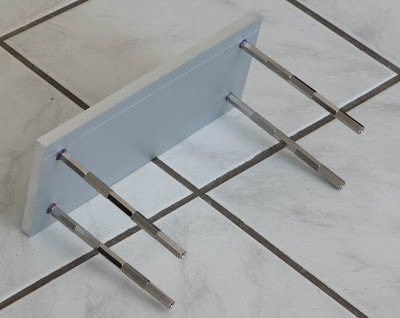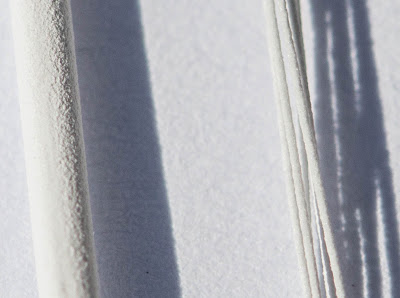In the previous posts about these simple mono amplifiers, we already had a detailed look at the schematic, all the parts needed and the initial construction steps. The last post showed the mounting of all components which go directly to the metal plate and the wiring of mains and heater connections as well as the high voltage AC.
Now we will go through the remaining assembly steps. All the parts which are still missing will be soldered to terminal strips. First we have to make a foundation on which these can be attached. For this I used my famous aluminum profiles:
These two aluminium rails are supported on bolts which are attached to the plate by a screw through a hole:
Now the terminal strips can be screwed onto these rails. Before they get mounted they need to be prepared a bit. Some holes drilled in the right distance:
Parts will be mounted on two tiers. Three strips in the first one:
Two of them are closer to each other. These are for shorter parts and some parts will be mounted vertically on the left side. At this point it is already important to think about the layout of the ground. A ground bus scheme will be used, so it is a good idea to orient as many parts as possible such that their ground connections are on one side.
Let's start with the two silicon diodes which complete the rectifier bridge:
The andodes of the diodes will be at ground. The cathodes are connected to high voltage AC. They are hooked up to the plate terminals of the rectifier tube socket through a well isolated twisted pair. Their orientation indicates already that we want the ground bus to run along the terminal strip in the middle.
Now the two electrolytics which are wired in series for the first cap after the rectifier, are added along with their parallel resistors:
On the top of the left column the two 100 Ohm resistors are placed, which create the ground reference for the heater. Their ground side is oriented towards the centre. The left side is connected to the heater of one of the signal tubes through a twisted pair of wires (blue wire). Since not much current is flowing through them, thin solid core wire can be used.
Now the second column gets populated with parts:
These are from the top: 1k cathode resistor of the 6N7 and it's bypass cap. Then the 500k grid to ground resistor of the output tube. Since I only had 1M parts in hand, two of them are connected in parallel. Below these the plate resistor of the driver 47k/20W. This dissipates a bit of power so we need a high wattage type. With this one we break the rule that all the solder lugs on the middle strip are for ground, since it connects to B+. We have to keep that in mind later on, when the ground bus is laid down. We need to jump over that. At the bottom the cathode resistor of the 6CB5A and it's bypass cap.
Now let's do the ground bus. For this we use a thick solid core copper wire. For example 1mm or thicker. First the insulation gets stripped off:
The insulation sleeve will be reused later. Don't throw it away. The bare copper wire is then bent into shape and soldered into the amp:
It runs all the way through the middle, jumping over the B+ connection of the 6N7 plate resistor and extends to the ground lift switch and ends at the minus pole of the speaker terminal. Another view from the side:
Now we add the connections to the signal tubes and some more of the missing parts:
The 100k input resistor is soldered directly to the RCA socket. The coupling cap from driver to output tube (yellow MKP cap between the two sockets) goes directly to the grid pins of the 6CB5A socket and to the plate resistor on the other side. From there another connection is made to the plate pins of the 6N7. Since we have some high voltage there some extra insulation is applied. In the photo above also the connection from the cathodes to the terminal strip is already done as well as the ground connection to pin 1 of the 6N7 (this grounds the shell in case a metal tube is used). The green resistor on the bottom makes the connection from the 6CB5A screen to it's plate. This resistor should be soldered as close to the screen pin as possible. For the plate connection the third solder lug from the bottom on the rightmost terminal strip is used. There we also connect the wire to the plate cap of the 6CB5A which is already in place in the photo. It extends through a hole in the metal plate to the top of the tube.
Remember the insulation from the ground bus wire which we kept? This is used for the wire to the plate cap which we want to be very well insulated. Some of the thin solid core wire is pulled though that sleeve:
First a longer piece of the insulation of the thin solid core wire is removed. This way it can be easily pushed into the black sleeve. When it extends at the other end, the sire can be pulled through so that we have the insulated part inside the black sleeve:
For extra protection I pulled this through a piece of the white sleeve and soldered the plate cap on:
Only a few parts missing: The bank of 5 electrolytic caps which will be wired in parallel for the main B+ reservoir cap, choke and output transformer. For the caps we need more terminal strips. These are mounted on two more aluminum rails which are attached to the lower rails with bolts:
Before these got added, I already soldered some wires to the strips underneath for the connections to the remaining parts: ground, B+ from the rectifier and first cap and output tube plate. After the upper tier is completed it is difficult to reach these, so better add them before.
Upper caps soldered in:
Now choke and output transformer get added and wired up:
Two more aluminium rails are used for this which again attach to the metal plate with bolts, long enough to keep them above the tube sockets. Extra insulation sleeves for the high voltage carrying wires.
Two more rails attached to the other ends of the choke and transformer. Another rail connecting these two for mechanical stability:
More bolts added which are needed to screw on the bottom lid, once the amp is inserted in the wooden frame.
Now everything is ready to be tested. After the test is complete the amp is put into the frame:
The bolts line up with holes in the bottom lid:
Through these everything is securely held in place by screws:
The bottom lid also carries the rubber feet on which the amp rests:
The finished amps:
Step by step testing and measurements will be covered in part 5. Stay tuned!
Best regards
Thomas



















































































